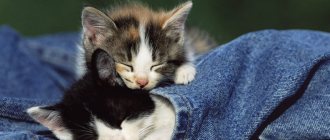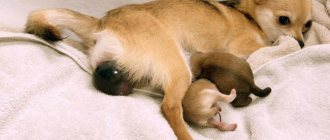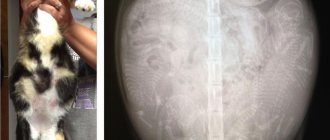There is a misconception that all cats easily bear kittens and give birth without outside help. However, purebred pets often require assistance both during gestation and at the birth stage.
Let's find out how a cat's pregnancy should proceed, what symptoms are a reason to see a doctor, and how a responsible owner should prepare for childbirth.
How long does pregnancy last in cats?
Pregnancy in cats can last from 63 to 67 days. These are average indicators, which are influenced by breed characteristics, number of kittens and other factors. Thus, long-haired breeds usually bear offspring for 10 weeks, and short-haired breeds - 9.
For each breed, the average duration of pregnancy is determined.
| Breed | Duration of gestation, days |
| British Shorthair | 63–69 |
| Scottish lop-eared | 62–69 |
| Bengal | 61–70 |
| Sphinx | 63–66 |
| Maine Coon | 66–68 |
| Oriental cat | 65–66 |
| Somali and Abyssinian | 63–65 |
| Persian | 63–66 |
| Siamese | 59–64 |
The average cat bears kittens for 65–70 days. These values are influenced by the quality of life, the animal’s nutrition, the presence of stress and physical health. Up to three pregnancies are possible per year, but such a frequency of births greatly depletes the body.
For this reason, yard cats cannot boast of their longevity. And it is customary to breed purebreds no more than 3 times every two years.
Important! If the animal does not have breeding value and there are no plans to produce offspring, it is better to carry out sterilization. The optimal age for the procedure is 7–8 months.
Maximum delay in labor
Cats carry kittens for about 2 months. If we take into account the average, a normal pregnancy lasts up to 72 days. If labor has not begun by this time, you should contact a veterinarian. Long term carrying of kittens is dangerous for both newborns and the cat.
Premature birth is no less risky. Kittens born on the 58th day of pregnancy or earlier are considered premature. They are weak and in most cases doomed to death.
Important! If a cat does not have a suitable birthing area, she may abort the contractions and pause labor.
When is a cat ready to become a mother?
Puberty in felines occurs in 4-5 months, and can last up to almost a year - this is influenced by many factors. The female can become pregnant at the age of 5-9 months. If she is walking on her own or there are several animals in the house, it is better to think about this in advance. Mating is considered optimal at one and a half years, when the body is fully formed and ready for pregnancy and the birth of kittens.
A lot also depends on the time of year. As a rule, sexual heat in street animals (they go to the toilet outside, go for walks) begins in January and continues until November. The peak occurs in the warm season. Pets are ready to breed all year round.
Most often, cats become pregnant in the summer, but in general it can happen at any time of the year.
Preparing cats for pregnancy
Planning pregnancy is the first and important step on the path to getting healthy offspring. First, anthelmintic treatment is carried out, and then comprehensive vaccination against viral diseases (panleukopenia, rhinotracheitis and calcivirus infection).
It is advisable for owners of a purebred animal to check their pet for genetic diseases to which a particular breed is prone. And to be completely sure that both animals are healthy, tests are carried out for coronavirus, immunodeficiency virus, herpes virus and other infections. Otherwise, infection can lead to a pathological course of pregnancy or cause physical abnormalities in kittens.
Artificial termination of pregnancy
There are often no medical indications for induced abortion in cats. Non-viable kittens themselves die in utero. Then they come out naturally or are removed surgically. In most cases, a cat has an abortion at the request of the owner.
There are two types of abortion in cats: medical and surgical.
Medication
- At 3-6 weeks of pregnancy, the cat is given prostaglandins, which cause miscarriage.
- At 6-9 weeks, abortion is performed using glucocorticoids.
Surgical
- Without sterilization: incisions are made in the uterine horns through which the fetuses are removed. The operation is performed on days 15-36 of pregnancy. This is a complex and expensive surgical procedure.
- With sterilization: the uterus and ovaries are removed. The operation is performed before the 7th week of pregnancy.
Often, medical abortions also end in surgical intervention due to the high risk of complications.
Abortion in most cases leads to the loss of reproductive function in the cat. In addition, the animal receives serious stress. Therefore, it is better to sterilize your cat before she becomes pregnant.
The female spends a lot of her body’s resources on pregnancy and childbirth. To ensure that cats have time to recover, experienced breeders breed them no more than once a year. It is worth noting that this process does not add health to the animal, but rather shortens the life of the female and puts her at risk of various complications. That is why it is worth breeding only animals that have value for breeding work. It is better to sterilize outbred cats.
Nuances and possible complications
During pregnancy, cats can experience complications that can be caused by infections, genetic diseases, and even external factors. The life and health of your pet will depend on timely detection of the problem and contacting a doctor.
False pregnancy
If the mating was not successful, or the embryos did not attach to the uterus, a false pregnancy may occur. In this condition, the cat appears all the signs of pregnancy: reddening of the nipples, increased appetite and body weight, drowsiness and search for a secluded place. But at the appointed time there will be no labor activity, as well as fetal movement.
It is impossible to independently determine whether a cat is pregnant or a false pregnancy has occurred. This is the task of a veterinarian. Only an ultrasound of the abdominal cavity or its palpation can clarify the situation.
Most often, false pregnancy is provoked by the following factors:
- overweight cat;
- mating with a castrated or too young cat;
- hereditary predisposition (the Oriental breed, Cornish Rex and Sphynx are prone to it);
- close proximity to pregnant cats;
- severe stressful situations.
False pregnancy is dangerous if it is characterized by a long course or occurs several matings in a row. The condition leads to depletion of the body and can provoke mastitis, pyometra and other dangerous diseases.
Preventive measures will help prevent its occurrence:
- proper and balanced diet;
- calm atmosphere in the house;
- early diagnosis by a veterinarian;
- mating with a healthy, proven cat.
To stop this pathological process, the doctor may prescribe sedatives, as well as drugs to stop the production of cat milk.
Frozen pregnancy
Sometimes a cat may experience a frozen pregnancy. Stopping embryo development occurs for a number of reasons:
- unsuccessful previous pregnancies;
- hormonal imbalances;
- some infectious diseases;
- pathologies of uterine development.
Such changes lead to the death of one or more embryos. Consulting a veterinarian will allow you to assess the situation and prevent dangerous consequences. After all, if left in the womb for a long time, a frozen fetus can begin to rot, infect healthy fruits and harm the cat itself.
In this situation, the doctor will help you make the right decision: wait for a natural birth so that the embryo comes out with healthy kittens, or begin to immediately stimulate labor. If all the embryos freeze, a miscarriage occurs.
Important! Ultrasound examination will allow you to determine if a cat is pregnant or find out about the pathology of the fetus. This procedure also determines the kittens' heartbeat and their rate of development.
Superfetation
An unusual phenomenon in cats is parallel pregnancy or superfetation. This term implies the conception and gestation of two broods at different stages of maturation. The process is observed if the cat is bred again when she is already pregnant. In this case, embryos develop in the uterus with a significant difference in time. The gestational age usually does not increase.
Superfetation most often ends in the death of late fruits. When labor occurs, they are pushed out. It is much less common for cats to give birth twice when the remaining kittens are successfully carried to term. When diagnosing a parallel pregnancy, it is recommended that the birth be carried out under the supervision of a veterinarian. This can increase the chances of survival of the younger litter.
What are the dangers of early pregnancy in cats?
The first heat indicates the cat's readiness to become pregnant. This process is individual for each cat and can occur from 6 to 11 months. However, its appearance is not a reason to plan a mating.
Experts tend to believe that it is better to introduce a cat for the first time no earlier than a year. By this time, the animal’s body will be fully strengthened and will be able to bear healthy offspring. And in teenage cats, pathologies of fetal development are often observed.
Popular questions and answers
We asked important questions about cat pregnancy to the felinologist, owner of the cattery, Elena Vishneva, and veterinarian Marina Mikheenko.
How long before pregnancy should a cat be vaccinated?
If the cat is not vaccinated, then vaccination must be carried out at least 1 month before the intended mating. And before vaccination, treat the cat with anti-helminth medications at least 10 days in advance.
Can pregnant cats be vaccinated?
Pregnant animals cannot be vaccinated; this can lead, for example, to abortion or a number of pathologies in the offspring. But, if there is a threat to the life of a cat, for example in a shelter, where there is a high risk of infection with, say, panleukopenia (which can be fatal), the veterinarian may decide to vaccinate.
Is it possible to pick up a pregnant cat?
You can and should pick up a cat in your arms to caress and stroke it. But any movements must be careful so as not to harm the fruit. Try not to pick it up by the belly, crush it, throw it, or cause discomfort to the animal.
What absolutely should not be done with a pregnant cat?
It is strictly forbidden to give the animal prohibited food, change the diet suddenly, do not give yourself any medications or medications prohibited during pregnancy, and limit stress.
Cats like everything to be as usual every day. Even the arrival of guests can cause stress in a cat. Sources
- Filippova O.V., Sorokin V.I. Ultrasound visualization of the genital organs as a method for assessing the state of pregnancy in cats and bitches // News of the Orenburg State Agrarian University, 2008 https://cyberleninka.ru/article/n/ultrazvukovaya-vizualizatsiya-polovyh-organov-kak-metod-otsenki-sostoyaniya- beremennosti-u-koshek-i-suk
- Soboleva A.A., Khokhlova S.N., Simanova N.G. Sterilization of cats // Innovative science, 2016 https://cyberleninka.ru/article/n/sterilizatsiya-koshek
Features of the first pregnancy
During the first pregnancy, special care, feeding and maintenance of the cat are required. There are certain recommendations for this period:
- With natural nutrition, a complex of vitamin and mineral supplements is introduced into the diet.
- When feeding dry food, preference is given to the line for kittens or pregnant cats.
- By the 6th week of pregnancy, the frequency of feedings increases. In total, 4–5 appointments are carried out per day.
- Regularly weighing your pet will help prevent overfeeding. But it can lead to a difficult birth.
How to care for newborns
First of all, you need to understand that a cat can mate on its own. On the contrary, it is better not to even hold the kittens again.
If there is something wrong with the cat, there is no milk or it has disappeared, in this case you can take care of the newborns and start feeding them. But not more.
The rest is up to the cat. After all, her instinct will be aimed at being a mother and protecting her offspring.
Cat pregnancy calendar by week
On average, a domestic cat gives birth 61–67 days after mating. The minimum period is 56 days, the maximum is 72 days. You can understand that a cat is pregnant after the third week. To do this, you should know what signs are inherent in each stage of fruit development.
1–3 week
Pregnancy in cats at this stage can only be determined using ultrasound. The study will also show how much fruit she bears. External signs appear towards the end of this period.
4–6 weeks
At the beginning of the fourth week, redness and swelling of the nipples will occur, and vomiting may occur. These are the main signs of pregnancy in a cat. From week 5, appetite increases. Animals become more affectionate and more demanding of attention from their owners. By week 6, the belly increases slightly.
7–9 weeks
From the 7th week, fetal movement can be felt. This sign is especially noticeable in short-haired breeds. The kittens in the belly begin to grow quickly, which affects its size. Now pregnancy is noticeable even to the naked eye. With the onset of the 9th week, it is recommended to prepare a secluded place for the pet to give birth and wait for the symptoms of its approach.
How to prepare a place for offspring?
During childbirth, the animal feels calmer in a quiet, secluded place, so you need to prepare a bed or box in advance. The peace of the last two weeks depends on the behavior of all household members. Young children especially should not fuss while waiting for a kitten, this will make the cat nervous.
Over time, you need to accustom the animal to a new resting place. But it also happens that for some reason the cat does not like the bed, then you just need to track where the animal tries to hide during childbirth.
Order pet products in Krasnoyarsk from the Pharmacia online pharmacy. Ordering products through online search is available with a discount of up to 10%.
Caring for a pregnant cat
During pregnancy, a cat's body is exposed to great stress. During this period, the animal especially needs proper nutrition, care and attention.
Features of feeding
If your pet's diet consists of industrial food, then for the period of gestation of kittens it is recommended to choose brands of at least super-premium class. Growing embryos and the mother's body need food rich in vitamins and minerals. These requirements are met by lines for kittens, pregnant and lactating cats.
With natural nutrition, the diet includes:
- boiled veal;
- meat broth;
- boiled sea fish;
- buckwheat, oatmeal and rice porridge;
- fruits and vegetables;
- boiled cartilage;
- chicken eggs;
- sour cream, cream, yogurt and other dairy products.
The cat is fed up to 5 times a day. And from the second month, the daily norm increases by 1.5–2 times. Despite the fact that the diet will consist of the right foods, this is not enough for the expectant mother and her offspring. Therefore, during pregnancy, a complex of vitamin and mineral supplements is additionally introduced.
Is it possible to get vaccinated?
The protection period of complex vaccines lasts up to a year. If you are about to breed a cat that has completed this period, or has no vaccination at all, you need to take care of it in advance. Vaccination is allowed one month before the expected date of mating.
Important! Administration of the vaccine to a pregnant cat can lead to miscarriage or pathologies in newborn kittens.
Is it possible to give medications?
The question of whether it is possible to give a pregnant cat medications and which ones should be decided by a veterinarian. Even if the instructions for the drug allow its use, the final word remains with the specialist. A specific decision is made based on practical experience and an assessment of the pet’s condition.
If you have doubts about the correctness of the prescribed medication, you can always consult another veterinarian and draw the right conclusion based on several opinions.
Is it possible to pick up a cat?
Pregnant cats walk for two months, and throughout this period they need affection and attention from their owners. It is simply necessary to pick up your pet, but you need to do it carefully. Squeezing the stomach, causing discomfort to the animal, or throwing it is strictly prohibited.
Waiting for offspring
The period of gestation of kittens is marked by several important stages.
The formation of embryos up to 1 cm in size occurs during the first three weeks from the moment the cat is fertilized. This internal process does not in any way affect the appearance of the animal. But this particular period is marked by changes in the pet’s behavior and a decrease in her appetite.
Over the next two weeks, the cubs grow to 4-6 cm. At this time, their bodies begin to be covered with tiny hairs. The cat's belly increases significantly, acquiring a pear-shaped outline, and by the 5th week it becomes noticeably thicker. The cat waddles, with swollen sides, and one gets the impression that the babies in her womb are a little cramped. However, if the kitty bears no more than two cubs, her belly does not increase too noticeably. During this period, an ultrasound examination will give an accurate conclusion regarding the number of kittens. You should not independently determine the number of offspring by palpating the cat’s tummy. This is dangerous for both babies and their mother.
From the seventh to the ninth week of the “interesting situation” the cat experiences the most crucial period. The intrauterine development of her cubs is completed, the weight of each of them reaches an average of 100 g, length - up to 8 cm. The bodies of the kittens are abundantly covered with fur. They are active, constantly moving, which is why the sides of the expectant mother move noticeably. It becomes obvious that the cat is experiencing discomfort due to a heavy belly. She tries to lie down longer, runs to the toilet more often, does not show increased interest in food, rejecting even her favorite treats. A week before giving birth, she begins to slightly release immature milk (colostrum), which dries out in the nipple area.
About 3-5 days before the kittens are born, the kitty begins to show obvious anxiety, looking for a secluded corner where she could “make” a cozy nest. Owners can help their pet solve this important issue by purchasing or making a soft, comfortable bed that can accommodate the entire cat family. On the eve of childbirth, the kitty begins to actively lick itself, its pulse quickens, and trembling occurs. She follows her owners around, not wanting to be left alone. At such times, she especially needs affection and attention, friendly instructions. Household members should not show nervousness, as negative emotions will only increase the animal’s anxiety.
Gestation of kittens ends with birth. The process can take from several hours to a day. If during this period the cat was unable to lamb on its own, the help of a veterinarian will be required. Difficulties during childbirth are often caused by the fact that the owners fed the pregnant animal, which is why the kittens turned out to be too large.
Preparing for childbirth
Responsible owners begin to prepare the cat even before mating. This applies to a balanced diet, medical examination, deworming and vaccination.
Healthy activity of the pet is the key to a favorable pregnancy. But in recent weeks it is worth protecting her from jumping on tables, cabinets and other high objects. If the landing is unsuccessful, the cat may hit its stomach and harm the kittens.
If the pet is giving birth for the first time, it is better for the owners to make an agreement with the veterinary clinic in advance. This is necessary to receive round-the-clock counseling and emergency medical assistance if necessary.
Place for birth
The cat gives birth in two months, and a week before the upcoming event she is in search of a secluded place. A good option is an exhibition tent or a special maternity complex. If there are none, a spacious bed, a drawer, or even a large box will do.
The main conditions are sterile cleanliness, absence of drafts, warmth and a calm atmosphere.
The preparation of the site must be taken responsibly. Otherwise, when the due date approaches, the cat will rush restlessly around the house. And after the end of labor, dragging the kittens is possible.
Mr. Cat explains: why are multiple kittens born?
A cat carries several babies at once. Five or six individuals is not something surprising. This is due to the peculiarities of the anatomical structure of the reproductive system.
A cat's uterus resembles the letter “U”. It has a base and two processes connected by the fallopian tube, which are longer than the reproductive organ. During conception, the eggs are transported to the uterus and attached to them. The area of the shoots is wider, so more offspring are born.
1111
Postpartum period
The absence of contractions for 2 hours and the prolapse of the abdomen indicates the completion of the birth process. The behavior of the female also changes: she calms down, her breathing evens out, she lies down more comfortably in the box, and continues to lick and feed the babies. You should not give food to a woman in labor immediately after birth, but you can offer water or milk. She usually drinks only when the process is over.
You need to carefully replace the diapers with clean ones and place a tray nearby so that the mother does not move away from the kittens for a long time. But it is not recommended to pick them up; the cat may lose interest in them or react aggressively to this. It's better to leave her alone for a while.
Symptoms of the onset of labor
Early warning signs of childbirth are sagging of the abdomen as a result of relaxation of the ligaments, as well as retraction of the sacral region.
On the eve of delivery, swelling of the genital organs and mammary glands occurs, and droplets of colostrum are released. Viscous mucus without pathological impurities comes out of the loop.
Read the article about bleeding in a pregnant cat.
When labor occurs, the water breaks, releasing a grayish-pink fluid. Then contractions appear, which normally last for an hour, which, if the outcome is favorable, end with the birth of offspring.
How to help a cat during its first birth
Usually a cat instinctively knows how and what to do during childbirth, but for the first time it may get scared and hide in an inaccessible place, for example, under the bed. Therefore, it is important for the owner to prepare in advance for such an important process.
How to prepare a place for childbirth
When giving preference to a place for childbirth, you need to adhere to some rules:
- Availability. Having made a box with bedding for a future woman in labor, it is important to make sure that she does not have to jump into it. You can cut out the door or remove part of the wall, then both the cat and the owner will have greater access inside.
- Capacity. It must be remembered that the pet, along with the born kittens, will be there not for one day, but for up to 2 months, so there should be enough space for both the mother and the growing offspring.
- Silence. Select a place in an apartment or house where it will be as quiet and peaceful as possible; this could be a secluded corner or the space between the sofa and the wall. Otherwise, the cat will start to worry and hide, for example, in a closet. This behavior indicates that she does not feel protected in the designated area and you need to think about moving her to a quieter place.
- Convenience. It is worth putting a layer of clean old cloth or gauze at the bottom of the box; you can buy special absorbent sheets at the pharmacy. This will create additional comfort for the woman in labor.
Routine ultrasound during pregnancy
A specialist can prescribe an ultrasound scan at almost any time during pregnancy if the animal’s condition is in doubt. In the early stages, the owner can contact the veterinarian to confirm or deny the presence of pregnancy.
Next, the development of the fetus is monitored and the number of future kittens is determined. In any case, a visit to the veterinary clinic is recommended both for preventive purposes and if you experience feelings of anxiety about the condition of your pet.
Scheduled ultrasound










